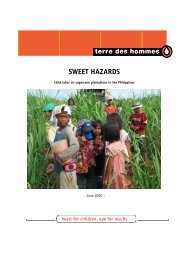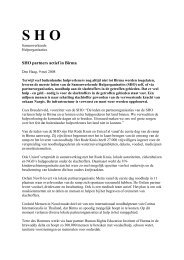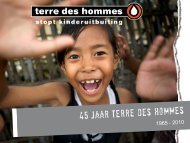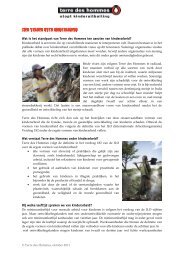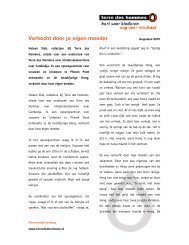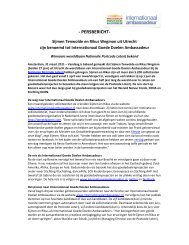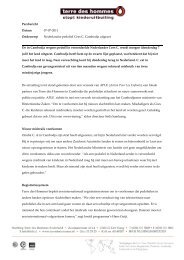Untitled - Terre des Hommes
Untitled - Terre des Hommes
Untitled - Terre des Hommes
- No tags were found...
You also want an ePaper? Increase the reach of your titles
YUMPU automatically turns print PDFs into web optimized ePapers that Google loves.
Bolivia<br />
1. Introduction and background to child exploitation<br />
There were 800,000 children estimated to be working in Bolivia in 2001 (UNICEF in <strong>Terre</strong> <strong>des</strong><br />
<strong>Hommes</strong> 2008: 35-36 ), but many believe this figure to be even higher. The Instituto Nacional de<br />
Estadística or National Statistics Institute (INE), together with UNICEF, estimated in 2004 that there<br />
were 493,553 children working in rural areas, 116,000 children aged seven to thirteen active in the<br />
goods and services sector and 729,000 adolescents from fourteen to seventeen performing some type<br />
of economic activity in Bolivia ( INE-UNICEF in <strong>Terre</strong> <strong>des</strong> <strong>Hommes</strong> 2008: 35-36). Child labour is also<br />
prevalent in the urban areas; 14% of children in Sucre are working according to Defensoría de la Niñez<br />
y Adolescencia (Local Ombudsperson for Children and Youth). Some of Bolivia’s working children are<br />
able to combine work and school, but many drop out of school in order to earn money. At the main<br />
cemetery in Cochabamba, for example, a large majority (91%) of the working children are also<br />
attending school 115 while only about 50% of the working children in Potosí are attending school. 116<br />
The conceptualizations of certain notions within Bolivian culture have implications for how child<br />
labour is viewed and dealt with in society. There is much debate around child labour going on in<br />
Bolivia and the interviewees to this report were split on varying aspects of the issue. Cecilia Erostegui<br />
from the Ministry of Foreign Affairs explains that in Bolivia there is no real concept of childhood as a<br />
separate stage of life, but that children are considered full members of the family, with a<br />
responsibility to contribute what they can to the household. Working alongside the family and<br />
contributing to the household income is seen as part of the child’s education and socialization<br />
process, especially in the rural areas. 117 Others, such as Silvia Escobar dne Pabon from the research<br />
centre CEDLA argue that child labour is not a cultural issue and that the majority of Bolivians in both<br />
rural and urban areas believe, at least in principle that children should be in school rather than<br />
working. 118 There is also a policy debate going on about children’s right to work versus their right to<br />
protection and hence about whether to regulate working conditions or to abolish child labour<br />
altogether. Defining which types of labour are exploitative is seen by some as central to judging<br />
which types of work children should have a right to do and what should be prohibited. Those on the<br />
abolitionist side of the debate feel that this distinction is arbitrary, and that children should not be<br />
involved in any type of work.<br />
Some of the background necessary to understanding child labour in Bolivia can be found by looking<br />
at family structures. It is common for men to migrate great distances for work; temporarily or<br />
permanently abandoning their families. There are many broken families and remarriages and it is<br />
common for children to face abuse and neglect at the hands of stepfathers. Often children do not form<br />
an emotional bond with their parents or siblings and in combination with the great amount of<br />
responsibility they take on at a young age, lead very independent lives from early on.<br />
Violence against children is a large-scale problem in Bolivia. According to a different study by INE<br />
and UNICEF (2007), half of Bolivia’s child population - about two million children - have been<br />
physically and psychologically abused at some point in their life (INFANTE 2009: 3). Although this<br />
abuse takes place in schools, in shelters, on the streets or at the hands of law enforcement agents, 83%<br />
of physical abuse happens within the family. Other data, by Ipas Bolivia and Marie Stopes<br />
115<br />
Mr. Cristóbel Gonzales Ugalda (Audiovisuales Educativos (AVE))<br />
116<br />
Ana Maria Janco (Care Potosí)<br />
117<br />
Cecilia Erostegui (Ministerio de Relaciones Exteriores)<br />
118<br />
Silvia Escobar dne Pabon (El Centro de Estudios para el Desarrollo Laboral y Agrario(CEDLA))<br />
51




